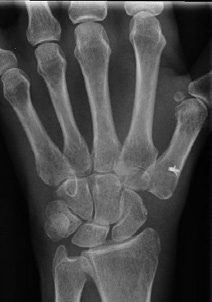
Basilar (Basal) Thumb Arthritis
The base of the thumb (the trapeziometacarpal joint) is the most common hand joint affected by painful arthritis. Approximately 11% of post-menopausal women develop painful arthritis of this joint. It may also occur in men who overuse the thumb, or who have had a thumb fracture.
The pain from basilar thumb arthritis is often worse with pinching and gripping, such as when opening up a jar or turning a key. It may progressively worsen until many hand activities become painful
Arthritis of the base of the thumb is diagnosed based on a history and physical examination (talking to you and examining your thumb), as well as by looking at the joint on X-rays.
Treatment always starts with non-operative management, including avoiding pinching and gripping ‘small’. When grasping or pinching a small object, for every 1 pound of force applied to the thumb tip, the basilar joint experiences 12 pounds of force. Pinching and gripping ‘big’ minimize the forces across the basilar thumb joint. Big, thick pens with rubber grips on them are much easier on this joint than are small, metal pens. Kitchenaid or simlar devices can slip over jar covers to make them larger and easier to hold. Devices that slip over keys to make turning them easier can be purchased. http://www.ncmedical.com/item_180.html Whenever gripping or pinching is necessary, try to make the object bigger.
A splint can also be helpful. Most patients prefer a soft, neoprene, rubber-like splint that doesn’t interfere much with hand function. A steroid injection can also provide good relief. If the symptoms are mild, these measures may be all that is needed. However, unfortunately, they will not provide permanent relief from the pain of more advanced arthritis.
LRTI Procedure
If non-operative management is not effective and the pain is significant, surgery can be a very effective cure. There are many different types of surgery for this problem. I prefer the LRTI (Ligament Reconstruction Tendon Interposition). The LRTI is the current ‘gold standard’, the most popular and most effective procedure for basilar thumb arthritis, with a low complication rate. It’s been around since the mid-1980s. The LRTI uses the body’s natural tissues to provide both stability and a new joint. This is one case where newer procedures that use artificial materials to create artificial joints are less effective and have a higher complication rate.
During the LRTI, the arthritic bone that the thumb rests on (the trapezium) is removed. A small cut is made in the forearm to release a tendon, which is moved to the base of the thumb to fill in the area from which the trapezium bone was removed. So now instead of the thumb resting on a hard piece of arthritic bone (which is painful), it rests on a soft tendon pillow. A small suture anchor is placed into a thumb bone. It’s like a small harpoon with stitches on it to hold everything together. It stays in forever. Video of LRTI
Basilar thumb arthritis often co-exists with carpal tunnel syndrome. If this happens, an endoscopic carpal tunnel release can be performed at the same time, with essentially no increase in post-operative pain.
Because the arthritic thumb doesn’t move well, the metacarpophalangeal (MP) joint may develop hyperextension due to laxity of its volar plate, the ligament that normally prevents hyperextension. This puts extra stress on the basilar thumb joint. If this occurs, the MP joint may need to be surgically addressed as well, at the same time with an MP joint ‘capsulodesis’. Please see the ‘Swan Neck of the Thumb’ section of this website for more information on this procedure.
Following LRTI, the post-operative splint is worn for roughly 1 week. Following the first post-operative office visit, a removable splint is worn for 5 weeks, except when bathing or doing motion exercises. Once the post-operative splint is removed, the hand may get wet, but the wound should not get dirty or be submerged under water for 10 days following surgery. Most patients need some hand therapy to regain thumb motion, but usually not more than a few sessions. The stitches are absorbable, and there are no stitches to remove.
While some patients note a fair amount of pain for the first few days after surgery, the surgical pain quickly decreases. It is important to avoid forceful gripping and heavy lifting for 4 months after LRTI. Typing and computer use are fine, and may be performed the day after surgery.


